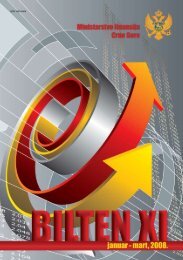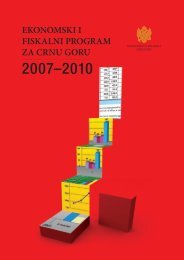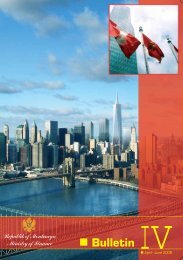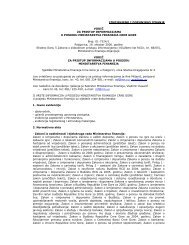Republic of Montenegro: Public Expenditure and ... - Vlada Crne Gore
Republic of Montenegro: Public Expenditure and ... - Vlada Crne Gore
Republic of Montenegro: Public Expenditure and ... - Vlada Crne Gore
Create successful ePaper yourself
Turn your PDF publications into a flip-book with our unique Google optimized e-Paper software.
36<br />
Chapter 2: Composition <strong>of</strong> <strong>Public</strong> <strong>Expenditure</strong> <strong>and</strong><br />
Key Sources <strong>of</strong> Fiscal Pressure<br />
2.60 Although the Government has made substantial efforts to reduce the size <strong>of</strong> public<br />
employment in the past four years, the public sector wage bill continues to represent a relatively<br />
heavy burden on the economy. Between 2002 <strong>and</strong> 2005, employment in the public<br />
administration fell by almost 14 percent (from 34,309 to 29,557 people). Yet, a comparison with<br />
regional states shows that <strong>Montenegro</strong>’s wage bill as a proportion <strong>of</strong> total government<br />
expenditure or GDP still remains far above average. On the other h<strong>and</strong>, capital expenditure is<br />
much below the level for other countries in the region.<br />
2.61 The prospect <strong>of</strong> European integration presents dual challenges to <strong>Montenegro</strong> <strong>and</strong> both<br />
require politically-challenging prioritization <strong>of</strong> resources. On the one h<strong>and</strong>, there is a need to<br />
build capacity in areas that are important for a fully functioning state within the EU. On the<br />
other h<strong>and</strong>, there is a need to assure that the cost <strong>of</strong> public employment does not squeeze the<br />
fiscal space needed to maintain existing infrastructure <strong>and</strong> to fund new programs. In order to<br />
achieve a fiscally sustainable wage bill, the Government should:<br />
• Develop a realistic strategy to reduce staffing in some areas, while exp<strong>and</strong>ing<br />
capacity in others. Eighty-seven percent <strong>of</strong> the wage bill is concentrated on just four<br />
functions—public order, defense, education, <strong>and</strong> health. All <strong>of</strong> the other functions <strong>and</strong><br />
institutions <strong>of</strong> government operate on the remaining 13 percent. Any future reductions in<br />
employment should therefore be targeted toward the four dominant sectors. On the other<br />
h<strong>and</strong>, there may be a need to increase staffing <strong>and</strong> administrative capacity in ministries<br />
that are central to the EU integration process (discussed in Chapter 3).<br />
• Control the pace <strong>of</strong>, <strong>and</strong> target, annual wage increases. The strong leverage <strong>of</strong> trade<br />
unions in salary <strong>and</strong> wage negotiations has meant a rapid increase in wages in recent<br />
years, in particular prior to 2004. Future increases in real salary rates should be highly<br />
targeted rather than implemented across-the-board. Without such fiscal discipline, there<br />
is a risk that the wage bill will crowd out essential spending on public goods <strong>and</strong> remains<br />
a drag on future economic growth.<br />
2.62 The case <strong>of</strong> education, the largest contributor to the government wage bill, illustrates the<br />
challenges as well as what the government can do. Out <strong>of</strong> the total recurrent expenditure on<br />
general education in 2004, 82.3 percent was spent on the wage bill, leaving only 17.7 percent <strong>of</strong><br />
total recurrent expenditure for non-staff items, which includes spending not only on classroom<br />
materials <strong>and</strong> teacher training but also utilities. A closer look at the fiscal structure in the sector<br />
shows, again, that the Government faces a clear choice between uncontrolled rises in salaries <strong>and</strong><br />
staff costs on the one h<strong>and</strong>, <strong>and</strong> spending on non-salary expenditures to pay for the reform<br />
agenda <strong>and</strong> to improve quality more generally on the other. This choice is particularly stark in<br />
the years 2006-2008. Some key steps that the government can take include:<br />
• Ensure strategic planning takes place within a clear budget framework. The costs <strong>of</strong><br />
the education strategy under preparation need to be properly assessed, within a rigorous<br />
priority-setting process. It is unfortunate that the Government approved the Strategy<br />
before this was done <strong>and</strong> therefore before it was possible to make an informed judgment<br />
that the costs can be met. In addition, funds (grants, credits <strong>and</strong> in-kind contributions)
















